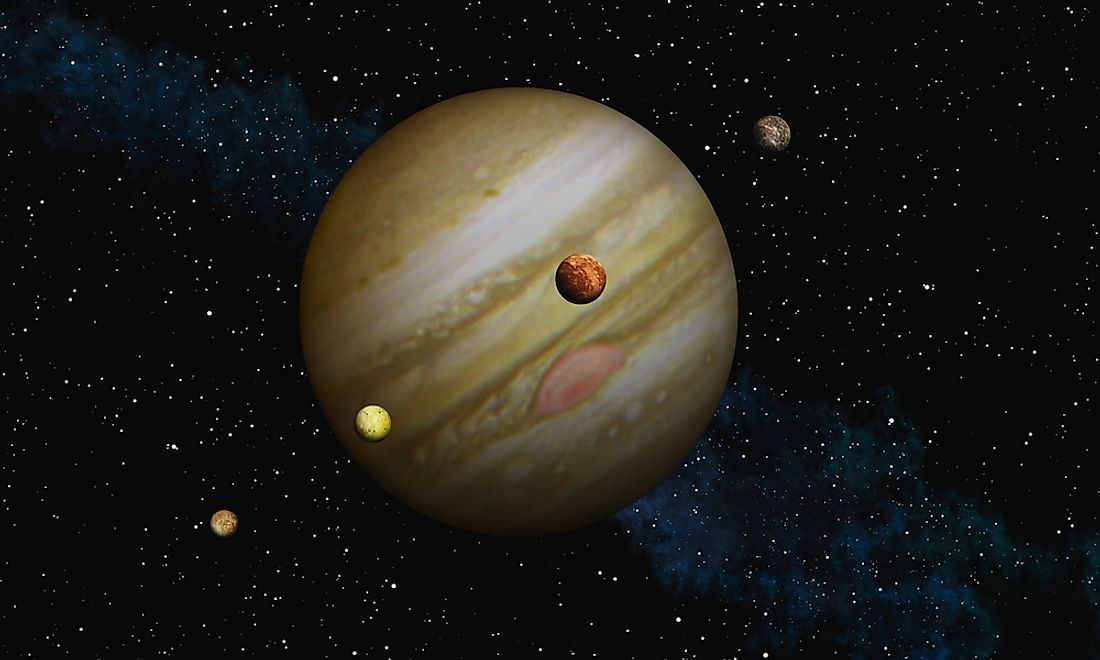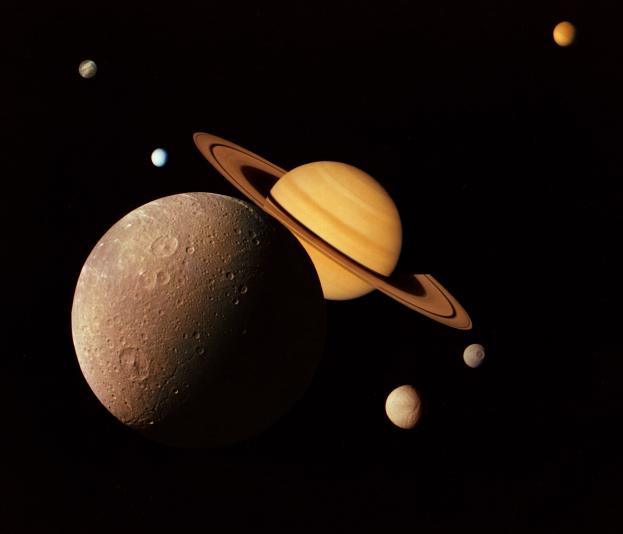The Moons of Jupiter
Jupiter has at leaset 62 moons. Most of these moons are very small, and were probably once asteroids that got too close to Jupiter. Jupiter’s large size means that it has very strong gravity. This powerful gravity sometimes grabs onto objects that wander too close.
Not all of Jupiter’s moons are captured asteroids though. Four of them are large moons which formed around Jupiter long ago. We call these moons the Galilean moons, because they were first discovered by an astronomer named Galileo. You can see the Galilean moons yourself through a pair of binoculars. Simply look towards Jupiter. The four tiny dots of light close by are the moons Io, Europa, Ganymede, and Callisto.
Inner Moons These four worlds are the closest known moons to the surface of the planet Jupiter. For this reason they are called the Inner Moons. |
|
Metis This moon was discovered by Stephen Synnott in 1979. In ancient mythology, Metis was a Titaness who was the first wife of Jupiter. Metis is the closest moon to the surface of Jupiter and can be found with in the planet’s main ring. This moon is probably an asteroid that got caught by Jupiter’s immense gravity. |
|
Adrastea Adrastea was discovered in 1979 by David Jewitt. In mythology, Adrastea was the god who passed out rewards and punishments, she was also the daughter of Jupiter. This moon is the second closest moon to the surface of Jupiter. Adrastea is probably an asteroid that got caught by Jupiter’s immense gravity. |
|
Amalthea Amalthea was discovered by Edward Emerson Barnard in 1892. Amalthea nursed Jupiter as a young baby using goat’s milk. Amalthea is the third closest moon to the surface of Jupiter. This moon is probably an asteroid that got caught by Jupiter’s immense gravity. |
|
Thebe The moon Thebe was discovered by Stephen Synnott in 1979. It was named after a nymph, daughter of the river god Asopus. Thebe is the fourth known moon from the surface of Jupiter. It too was probably and asteroid at one time. |
|
Galilean Moons In the early 1600’s, an Astronomer named Galileo Galilei looked at the sky for the first time using a telescope. He was the first scientist to ever use a telescope to study outer space. When he looked at Jupiter, he discovered four moons. Today we know that Jupiter actually has at least 62 moons. Only four of its moons are big enough to be seen through the small type of telescope that Galileo was using. Today we call these four large moons the Galilean moons. |
|
Io Io is a very violent place where a human would not live long enough to enjoy the beautiful colors it contains in its land formations. Io lies within a dangerous part of Jupiter’s magnetic field. The radiation found in this area is a thousand times stronger than what is needed to kill a Human. If you somehow survived the radiation you would still be in trouble because Io is covered with giant volcanoes which erupt with extreme frequency. These volcanoes spurt out large amounts of sulfuric acid into the air which falls, causing the beautiful reds, yellows and oranges of Io’s appearance. Io is the third largest of Jupiter’s moons, and slightly larger than the Earth’s moon. It was named after a woman whom Jupiter fell in love with. |
|
Europa Europa is a cold, smooth, ice covered world. A long time ago in space there was a period of time when it was very common for asteroids and comets to hit other worlds. This is called the Heavy Bombardment Period. During this time most worlds, including Earth, were scarred with bowl shaped impressions called craters. Most worlds remain scarred today. However, some, like the Earth, have since recovered their surfaces with new rock lava or ice, hiding these scars. Because Europa is smooth, we know it too has recovered its surface since the Heavy Bombardment Period. This, along with a few other clues, has led scientists to believe that beneath its icy outer shell lies a liquid water ocean heated by Europa’s hot core. This makes Europa the most likely place for life to exist outside of the Earth. Europa was named after a Phoenician princess abducted to Crete by Zeus. |
|
Ganymede Like Europa, it has recently been discovered that Ganymede probably has a liquid water ocean underneath its icy exterior. Ganymede is the largest of Jupiter’s moons. It is larger in diameter than both the planets Mercury and Pluto. Ganymede was named after a very handsome Trojan boy who Zeus took away to be the cup bearer for the gods. |
|
Callisto Callisto is the eighth moon from the surface of Jupiter, and the second largest. This moon was named after a nymph, loved by Zeus but hated by Hera. Hera changed her into a bear, Zeus then placed her in the sky as the constellation Ursa Major. Callisto is almost the same size as the planet Mercury. |
|
Outer Moons The following are the outer moons. They are the furthest moons from the surface of the planet Jupiter. |
|
Leda Leda is the ninth moon from the surface of Jupiter. This world is also the smallest of Jupiter’s moons. It was discovered by Charles Kowal in 1974. The name “Leda” comes from a queen of Sparta and the mother, by Zeus in the form of a swan, of Pollux and Helen of Troy. This moon was almost certainly an asteroid at one time. |
|
Himalia Himalia is the tenth moon from the surface of Jupiter. It was discovered by Charles Perrine in 1904. Himalia was named after a nymph who bore three sons of Jupiter. |
|
Lysithea The eleventh moon from Jupiter’s surface is Lysithea. In ancient mythology, she was the daughter of Oceanus. Lysithea was discovered in 1938 by Seth Nicholson. |
Sorry no pictures available |
Elara Elara was discovered by Charles Perinne in 1905, and is the twelfth moon from Jupiter’s surface. It is named after the mother by Zeus of the giant Tityus. |
Sorry no pictures available |
Ananke The thirteenth moon from Jupiter was discovered in 1951 by Seth Nicholson. Ananke is named for the mother of Adrastea, by Jupiter. |
Sorry no pictures available |
Carme Carme is Jupiter’s fourteenth moon. It was discovered in 1938 by Charles Nicholson. Carme was the mother, by Zeus, of Britomartis, a Cretan goddess. |
Sorry no pictures available |
Pasiphae Jupiter’s fifteenth moon, Pasiphae, was discovered by P. Melotte in 1908. Pasiphae was the wife of Minos and mother, by a white bull, of the Minotaur |
Sorry no pictures available |
Sinope Sinope is Jupiter’s sixteenth moon. It was discovered by Seth Nicholson in 1914. Sinope was a woman who was courted unsuccessfully by Jupiter. |
Sorry no pictures available |
New Moons The following moons have only recently been discovered by scientists. We do not know much about these worlds yet. W1302, W1700, W1704, W1704_2, W1800, W1903_s, W1805, W1902, W1904, W2002_2, and W1700_2. |
|
















